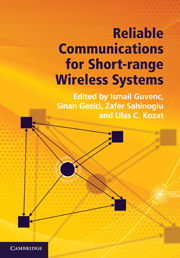Book contents
- Frontmatter
- Contents
- List of contributors
- 1 Short-range wireless communications and reliability
- Part I High-rate systems
- Part II Low-rate systems
- Part II Selected topics for improved reliability
- 11 Cooperative communications for reliability
- 12 Reliability through relay selection in cooperative networks
- 13 Fundamental performance limits in wideband relay architectures
- 14 Reliable MAC layer and packet scheduling
- Index
12 - Reliability through relay selection in cooperative networks
from Part II - Selected topics for improved reliability
Published online by Cambridge University Press: 01 June 2011
- Frontmatter
- Contents
- List of contributors
- 1 Short-range wireless communications and reliability
- Part I High-rate systems
- Part II Low-rate systems
- Part II Selected topics for improved reliability
- 11 Cooperative communications for reliability
- 12 Reliability through relay selection in cooperative networks
- 13 Fundamental performance limits in wideband relay architectures
- 14 Reliable MAC layer and packet scheduling
- Index
Summary
This chapter first presents an overview of the possible signaling techniques in relay networks. The differences between the formation of the signals of the relays, network performance, and complexity are highlighted. Then, the problem of relay selection is reviewed and key factors in the design of relay selection schemes are described. Finally, as a case study, the details of one exemplary relay selection protocol are presented.
Introduction
The demand of high data rates due to the explosive growth in data centric applications drives further innovations in wireless communication systems. Novel techniques have been developed to improve the reliability of wireless links and to boost their data rates. The main novelty in those techniques in the last decade is to exploit the characteristics of the wireless medium rather than to suppress its features. Examples of these techniques include opportunistic communications, multiple-input-multiple-output (MIMO) communications, and cooperative communications (see reference [1] and references therein). Cooperative communications exploit one of the main features of the unguided wireless medium: the broadcast feature. The broadcast feature has been regarded as a negative feature, since it is the source of the interference dilemma of radio communications. The same feature allows nearby nodes of a transmitting source to overhear the transmission and in turn to possibly relay the signal to a destination. Thus, nodes can cooperate to overcome the limitations set by the wireless channel. This idea has led to the notion of cooperative communications [2].
- Type
- Chapter
- Information
- Reliable Communications for Short-Range Wireless Systems , pp. 326 - 346Publisher: Cambridge University PressPrint publication year: 2011



